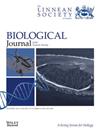关于在动物研究中使用色彩明度的评论
IF 1.5
3区 生物学
Q3 EVOLUTIONARY BIOLOGY
引用次数: 0
摘要
色光因其在体温调节、病原体抵抗和光保护等方面的多种功能而受到广泛关注。然而,色光功能的理论基础与黑色素色素密切相关。因此,我们在此讨论,忽视其他颜色产生机制可能会使结果的解释出现偏差。一般来说,色明度被不加区分地用作黑色素化的衡量标准。然而,动物所表现出的颜色可能来自黑色素以外的多种色素和结构机制。我们的主要论点是,在了解颜色产生机制和验证相关生理参数之前,不应不加区分地使用色光度。例如,将色光度作为热或光保护功能的替代物,必须对蝶呤、omochromes 和结构色进行验证。本文章由计算机程序翻译,如有差异,请以英文原文为准。
A critique of the use of colour lightness in animal studies
Colour lightness has received considerable attention owing to its diverse functional aspects, such as in thermoregulation, pathogen resistance, and photoprotection. However, the theoretical basis underlying the function of colour lightness is closely related to melanin pigments. Therefore, here we discuss that neglecting other colour-producing mechanisms may bias interpretation of the results. In general, colour lightness is indiscriminately employed as a measure of melanization. Nevertheless, animals may exhibit colours that derive from several pigmentary and structural mechanisms other than melanin. Our primary argument is that colour lightness should not be used indiscriminately before knowing the colour-producing mechanism and validating correlated physiological parameters. For instance, the use of colour lightness as a proxy for thermal or photoprotection function must be validated for pterins, ommochromes, and structural colours.
求助全文
通过发布文献求助,成功后即可免费获取论文全文。
去求助
来源期刊
CiteScore
4.30
自引率
10.50%
发文量
140
审稿时长
3-6 weeks
期刊介绍:
The Biological Journal of the Linnean Society is a direct descendant of the oldest biological journal in the world, which published the epoch-making papers on evolution by Darwin and Wallace. The Journal specializes in evolution in the broadest sense and covers all taxonomic groups in all five kingdoms. It covers all the methods used to study evolution, whether whole-organism or molecular, practical or theoretical.d.

 求助内容:
求助内容: 应助结果提醒方式:
应助结果提醒方式:


